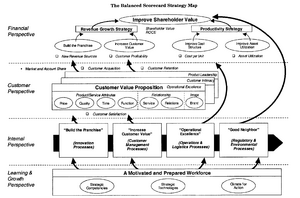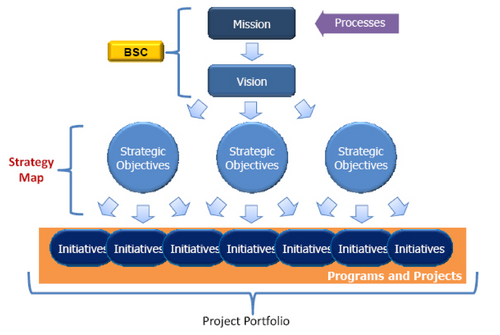Application of Balanced Scorecard in Portfolio Management
Contents |
Abstract
In this article the application of Balanced Scorecard (BSC) will be investigated in relation to Project Portfolio Management (PPM). BSC is a strategic planning tool, which addresses the strategic objectives and often measures them in form of Key Performance Indicators which is evaluated, reported and incorporated into a strategic feedback-loop[1]. Each executed project within a portfolio should be aligned with the strategic objectives in the organisation. To ensure the linkage between each project and the strategic objectives, balanced scorecard can be applied and provide the PPM with a set of initiatives and measures, which would indicate if the outcomes from a given project provides the expected returns or growth to the portfolio and organisation.[2][3][4]
To facilitate the merge between strategic management and portfolio management this article will present an argumentation of why BSC benefits PPM, including a definition of both PPM and BSC, the direct linkages in between and a reasoning for application based on theory. This will be followed by how the application of BSC in PPM should be initiated and an identification of the strength and weaknesses. Also the limitations and risks derived from the application of BSC will be identified and elaborated. To inspire further reading an annotated bibliography will be conducted, to enhance the understanding of the tool and core literature.
Definitions
In this section all theories and definitions will be outlined and discussed. The purpose is to give the reader an enhanced understanding of the BSC and the linkage to PPM.
Balanced Scorecard
BSC is a framework and tool which enable the opportunity for a company to describe its intangible and tangible assets. It does not try to valuate the intangible assets but to provide measures to evaluate these. [1] Furthermore, BSC differentiate from traditional balance sheets[5], through its describtion of intangible assets and not only tangible assets, such as materials, lands, equipment etc.[1]
The definition of BSC by Kaplan and Norton (2001) together with the definition by Abernethy et al. (2005) used as the baseline of reasoning to application into PPM:
1) "The Balanced Scorecard describes how intangible assets get mobilized and combined with intangible and tangible assets to create differentiating customer-value propositions and superior financial outcomes."[1]
2) "...it [balanced score card] articulates the links between leading inputs (human and physical), processes, and lagging outcomes and focuses on the importance of managing these components to achieve the organization's strategic priorities" [6]
Strategy Maps

The article by Tharp (2007), she addresses some of the current weaknesses which is identified in the executive management. One of the major weaknesses she identify is: "Many companies fail to distinguish between operational effectiveness and strategy."[2] This distinguish is very important to ensure a future perspective and to achieve an excellent, effective and efficient operational culture. [4]
In relation to BSC, it is very important that the strategy defined by the executive management is perceived and translated into operational targets and measures. [2] [4] Also BSC is an excellent framework to realize this and closing the gap that often exists. BSC contain both a high level strategic view and works as an enablers to translate the strategy into measures and targets, which directly relates to PPM and initiatives [4]
A highly recommended approach to ensure that the strategy is sufficient developed and transparent is to apply the framework of the "Strategy Maps". Strategy maps is a a logical and comprehensive architecture to describe the strategy, through all its elements and linkages to the organizational strategy. [1][4] An example of the framework can be seen in Figure 1. The strategy maps in interplay with the BSC provide a common and understandable reference point of the strategy for all organisational units and employees. [1] Which will help to minimize the "Vision Barrier" which result in 95% of the workforce not understanding the strategy and their contribution to it, resultingt in an ineffective and inefficient project management across the entire portfolio. [7]
With a well defined and transparent strategy, the PPM will be able to define actions to accomplish the strategy and objective goals, while manageging the all programmes and projects. Which will result in increase in value creation and production capabilities. [8]
The Four Perspectives
Both the BSC and the strategy maps framework is based on the four perspectives in which strategic objectives can be organized. [1][2][7]
Financial Perspective
The financial perspective concern the aspects of the strategy which directly impact the shareholder value.[1][2] Its a critical perspective in business which operate to increase value and generate value to the shareholders. Also it measures the very bottom-line of the company. [7] It is an easy perspective to measure, but the perspective is very limited, in the horizon and is only able to look backwards and therefore is more likely to determine short term strategic decisions. [2] In relation to PPM, measures in this perspective could be profitability, growth, shareholder value and budgets. [2]
Customer Perspective
In any business strategy the core is the customer value proposition. It differentiates a company from it competitors in attracting, retaining and deepening customer relationship.[1][7] Many of the market leaders have only chosen one discipline and excels within it, the disciplines is: Operational excellence, Product leadership and Customer intimacy. [7] Lastly its important, that this perspective do not solely consists of customer surveys, but should include measurable like response time, customer acquisition and customer loyalty.[2][7]
Internal Process Perspective
This perspective address organizational and operational measures in which a company when excels is providing good financial performance and excellent value proposition to reach the customers.[1][7] It consist of four high-level processes: 1. build the franchise, 2. Increase customer value, 3. achieve operational excellence and 4. Become a good cooperate citizen. [1] Measures in this perspective when considering PPM could include operational availability, reliability and post-sale processes.[2]
Learning and Growth Perspective
The last perspective is the Learning and Growth Perspective, this perspective is the enabler of the three previous. It is the foundation for the BSC, since it concerns the employees and informative systems, which let you reach ambitious results and achieve a leading market position. During the identification of the other measures, it is mostly certain that significant gaps will be identified during development of this perspective, these would likely concern the human, informational and organizational capitals. Measures in relation to PPM could be planning accuracy, employee development and availability of information.[2][7] When this as the last perspective have been developed, then the strategy map is complete across all four perspectives of the strategy.[1]
Key Performance Indicators
In relation to BSC, Kaplan and Norton (2001) has identified during 200 consultancy projects, two main types of BSC. The first one is the Key Performance Indicator BSC (KPI-BSC) and the second is the Stakeholder BSC (S-BSC). In this section the KPI-BSC will be discussed, while the S-BSC will follow in next section.[1]
The KPI-BSC is one of the major BSC types. KPI-BSC is typically straight forward to implement, since it is often based on already existing KPIs within the organization. The identified KPIs need to be classified into the four above stated perspectives to ensure that they address the entire project portfolio and all the aspects. It is important that the KPI-BSC do reflect the entire strategy of the organization and not only parts, which is often the case. By looking solely at the KPI-BSC a person should be able to tell what the organizational strategy is, since it should based upon that. Also the linkages between a specific KPI and its contribution to strategic objectives should be clarified and have a common acceptance. [1]
Stakeholders
The second main type of BSC is the S-BSC. In this type the organization identifies all it stakeholders, including shareholders, employees, customer, suppliers and their point of contact with the community in which they engage. Then the organization develop goals for all these stakeholders and follow this by a set of measures and indicators. The S-BSC described, is not fulfilling the definition of the BSC, but by adjusting measures and indicators to also concern the aspect about how the organization is going to achieve this, while concerning the overall organizational strategy and their internal processes, then the S-BSC would be sufficient in the definition of a BSC.[1]
Either of the KPI-BSC nor the S-BSC is sufficient on their own, but in either a cooperation or an inspired conceptualization based on the four perspectives, both can fulfill the definition of a BSC. Each PPM is different and the design of the BSC framework should carefully be considered and changed to match the strategy of the organization.
Project Portfolio Management
Linkages

Identification of Need
Implimentation
Steps
Strengths
Weaknesses
Limitations
Risks
Annotated Bibliography
Project Management Institute. (2018). The standard for portfolio management.
Toledo, R. (2011). From the balanced scorecard to the project portfolio. Paper presented at PMI® Global Congress 2011—North America, Dallas, TX. Newtown Square, PA: Project Management Institute.
Kaplan, R. S., & Norton, D. P. (2001). Transforming the Balanced Scorecard from Performance Measurement to Strategic Management : Part I, 15(1), 87–104.
References
- ↑ 1.00 1.01 1.02 1.03 1.04 1.05 1.06 1.07 1.08 1.09 1.10 1.11 1.12 1.13 1.14 1.15 Kaplan, R. S., & Norton, D. P. (2001). Transforming the Balanced Scorecard from Performance Measurement to Strategic Management : Part I, 15(1), 87–104.
- ↑ 2.0 2.1 2.2 2.3 2.4 2.5 2.6 2.7 2.8 2.9 Tharp, J. (2007). Align project management with organizational strategy. Paper presented at PMI® Global Congress 2007—Asia Pacific, Hong Kong, People's Republic of China. Newtown Square, PA: Project Management Institute.
- ↑ Toledo, R. (2011). Bridging the strategy gap. PM Network, 25(6), 18.
- ↑ 4.0 4.1 4.2 4.3 4.4 Olivier, A. J. (2007). Guideline for travelling [i.e. traveling] from vision to projects and back. Paper presented at PMI® Global Congress 2007—EMEA, Budapest, Hungary. Newtown Square, PA: Project Management Institute.
- ↑ Taggart, R. A. (1977), A MODEL OF CORPORATE FINANCING DECISIONS. The Journal of Finance, 32: 1467-1484. doi:10.1111/j.1540-6261.1977.tb03348.x
- ↑ Abernethy, M.A., Horne, M.H., Lillis, A.M., Malina, M.A., & Selto, F.H. (2005). A multi-method approach to building causal performance maps from expert knowledge, Management Accounting Research, 16(2), 135–155.
- ↑ 7.0 7.1 7.2 7.3 7.4 7.5 7.6 7.7 Niven, P.R. (2002) Balanced Scorecard Step-by-Step New York, NY: John Wiley & Sons
- ↑ 8.0 8.1 Toledo, R. (2011). From the balanced scorecard to the project portfolio. Paper presented at PMI® Global Congress 2011—North America, Dallas, TX. Newtown Square, PA: Project Management Institute.
- ↑ Project Management Institute. (2018). The standard for portfolio management.
- ↑ Alsadeq, I., Fatehy, T., & Othman, O. (2009). PMI® and BSC marriage! Where can PMI standards meet balanced scorecard? Paper presented at PMI® Global Congress 2009—EMEA, Amsterdam, North Holland, The Netherlands. Newtown Square, PA: Project Management Institute.
- ↑ Hoffman, W. (2004). The view from 50,000 feet. PM Network, 18(7), 26–33.